Hyundai Getz 2008 Owner's Manual
Manufacturer: HYUNDAI, Model Year: 2008, Model line: Getz, Model: Hyundai Getz 2008Pages: 383, PDF Size: 9.23 MB
Page 361 of 383
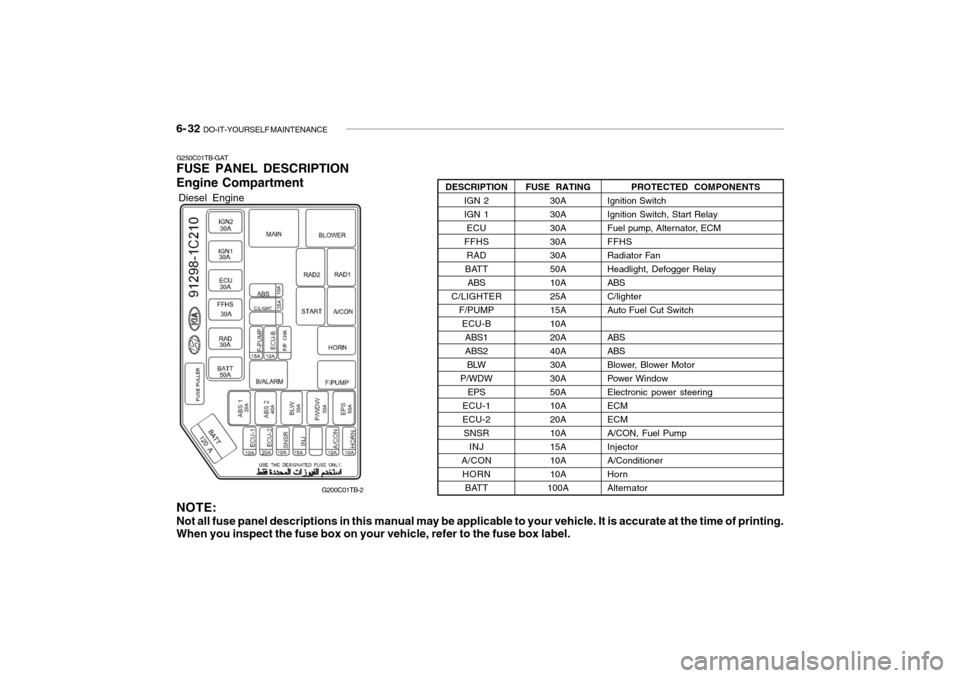
6- 32 DO-IT-YOURSELF MAINTENANCE
G250C01TB-GAT FUSE PANEL DESCRIPTION Engine Compartment
PROTECTED COMPONENTS
Ignition Switch Ignition Switch, Start Relay
Fuel pump, Alternator, ECMFFHS
Radiator FanHeadlight, Defogger RelayABSC/lighterAuto Fuel Cut Switch ABS ABS
Blower, Blower Motor
Power WindowElectronic power steeringECMECMA/CON, Fuel PumpInjectorA/ConditionerHornAlternator
FUSE RATING
30A30A30A30A30A50A10A25A15A10A20A40A30A30A50A10A20A10A15A10A10A
100A
DESCRIPTION
IGN 2IGN 1ECU
FFHS RAD
BATT ABS
C/LIGHTER F/PUMPECU-BABS1ABS2BLW
P/WDW EPS
ECU-1ECU-2 SNSR INJ
A/CON HORN BATT
NOTE: Not all fuse panel descriptions in this manual may be applicable to your vehicle. It is accurate at the time of printing. When you inspect the fuse box on your vehicle, refer to the fuse box label.
Diesel Engine
G200C01TB-2
Page 362 of 383
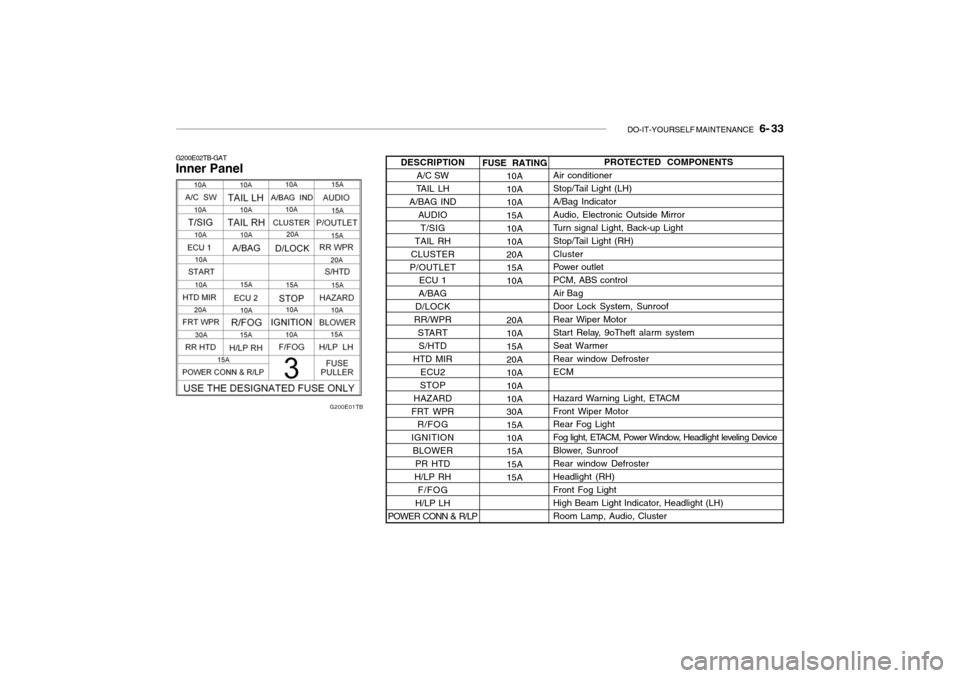
DO-IT-YOURSELF MAINTENANCE 6- 33
G200E01TB
G200E02TB-GAT Inner Panel
FUSE RATING
10A 10A10A15A10A10A 20A 15A10A 20A 10A 15A20A10A10A10A 30A 15A10A15A15A15APROTECTED COMPONENTS
Air conditioner
Stop/Tail Light (LH) A/Bag IndicatorAudio, Electronic Outside Mirror
Turn signal Light, Back-up Light
Stop/Tail Light (RH)Cluster
Power outlet PCM, ABS controlAir BagDoor Lock System, SunroofRear Wiper Motor
Start Relay, 9oTheft alarm system Seat Warmer Rear window DefrosterECM
Hazard Warning Light, ETACM Front Wiper Motor Rear Fog Light
Fog light, ETACM, Power Window, Headlight leveling Device
Blower, SunroofRear window DefrosterHeadlight (RH)Front Fog Light
High Beam Light Indicator, Headlight (LH) Room Lamp, Audio, Cluster
DESCRIPTION
A/C SW
TAIL LH
A/BAG IND
AUDIO
T/SIG
TAIL RH
CLUSTER
P/OUTLET ECU 1
A/BAG
D/LOCK
RR/WPR STARTS/HTD
HTD MIR ECU2
STOP
HAZARD
FRT WPR R/FOG
IGNITION BLOWER PR HTD
H/LP RH F/FOG
H/LP LH
POWER CONN & R/LP
Page 363 of 383

7. EMISSION CONTROL SYSTEM
Emission control systems ............................................................... 7-2
Catalytic converter ........................................................................... 7-3
EGR system .................................................................................... 7-4
7
Page 364 of 383

7- 2 EMISSION CONTROL SYSTEMS
SH010A1-E EMISSION CONTROL SYSTEMS (Not all models) Depending upon the market for which the vehicle is destined, the emissioncontrol system will comprise one or more of the following emission con- trol devices.
1) Crankcase emission control sys-
tem
2) Evaporative emission control sys-
tem
3) Exhaust emission control systemIn order that the proper functioning of the emission control systems may be ensured, it is recommended that the vehicle is inspected and maintainedby a Hyundai authorised repairer in accordance with the maintenance schedule in this manual. SH010B1-E
1. Crankcase emission
controlsystem
The positive crankcase ventilation
system is employed to prevent airpollution caused by blow-by gasesbeing emitted from the crankcase by introducing fresh air to the crankcase through the air cleaner where thismixes with blow-by gases and then passes through the PCV valve into the intake manifold from where it sub-sequently enters the combustion chamber and is burned.
SH010C1-E
2. Evaporative emission control
system
The Evaporative Emission Control
System is designed to prevent fuel vapours from escaping into the atmo- sphere through the fuel tank ventila- tion system. SH010D1-E
3. Exhaust emission con trol
system
The exhaust emission control system
is a highly effective system whichcontrols exhaust emission while main- taining good vehicle performance. Whilst the engine is not running, fuel
vapours generated inside the fuel tank are absorbed and stored in a char-coal canister. When the engine is started, the vapours stored in the canister are drawn into the inductionsystem through the purge control sole- noid valve and are subsequently burned.
The purge control solenoid valve is
controlled by the ECU; when the en-gine coolant temperature is low or the engine is idling, the purge control valve is closed and fuel vapours re-main stored in the canister. Under normal running conditions when the engine is warm, the valve opens andthe vapours are drawn into the inlet tract and subsequently burned in the combustion chamber.
Page 365 of 383

EMISSION CONTROL SYSTEMS 7- 3
H020A01TB-EAT
CATALYTIC CONVERTOR OP- ERATION PRECAUTIONS ; For a Petrol engine
Hyundai Getz models are fitted with
catalytic convertors which require special operating considerations. Thecatalytic convertor serves to oxidize certain noxious elements of the ex- haust gases leaving the engine toreduce the level of pollutants emitted from the vehicle and, provided that care is exercised to prevent damage,the catalyst will operate efficiently for the life of the vehicle.
It is of the utmost importance that the
following information is read and un-derstood by the vehicle operator in
HTB5017Catalytic Converter order to prevent operational problems arising from damage to the catalyst.
Damage to the catalyst will result if
contamination occurs through the use of leaded fuel. Whilst the vehicle isfitted with a reduced diameter filler neck to prevent charging of the fuel tank with a leaded fuel pump nozzle,it is possible that the use of funnels or fuel cans will permit leaded fuel to be introduced into the fuel tank.
The catalyst is intolerant of unburnt
fuel and therefore if an engine misfirecondition exists, damage to the cata-lyst will occur. It is imperative that if a misfire condition develops, the ve- hicle is immediately presented to aHyundai dealer for rectification. Simi- larly, the practice of certain ignition system diagnosis procedures whichinvolve inducing a misfire (cylinder power balance tests for example) may result in catalyst damage.
For these reasons, it is advisable that
the exhaust gas emission be testedat each routine service with a gas analyzer having a Hydrocarbon mea- suring facility to ensure continuedreliability of the catalyst. Push or tow starting of the vehicle is to be avoided since unburnt fuel may enter the catalyst and result in dam-age. (Note, it is impossible to push or tow start a Hyundai model equipped with fuel injection since the fuel pumpsafety interlock will prevent the pump from operating under these conditions). Operation of the catalyst involves ex- tremely high temperatures being at- tained within the catalytic convertor,and although the convertor is fitted with heat shields, it is important that the vehicle is not parked over combus-tible or volatile material which may result in fire. If the above precautions are not ad- hered to and the catalyst becomes inoperative, the resultant increase in core temperature will result in a "meltdown" where the catalyst core will melt and subsequently may block the exhaust system.Due to the fragile nature of the cata-lyst element, it is important that dam-age does not occur when the vehicle is raised by means of a garage jack. Care must also be exercised to avoiddriving over road hazards or debris which may cause damage to the cata- lyst element.
Page 366 of 383

7- 4 EMISSION CONTROL SYSTEMS
H020D01S-GAT ; For a diesel engine All Hyundai vehicles are equipped with oxidation type catalytic converter to reduce the carbon monoxide, hy-drocarbons and particulate contained in the exhaust gas. H020C01S-GAT EGR SYSTEM ; For a diesel engine This system helps control oxides of nitrogen by recirculating a part of the exhaust gas into the engine.
Page 367 of 383

8. CONSUMER INFORMATION
Vehicle Identification Number (VIN) ............................................... 8-2
Engine number ................................................................................. 8-2
Tyre pressures ................................................................................. 8-3
Snow tyres ....................................................................................... 8-4
Tyre chains ...................................................................................... 8-4
Tyre rotation ..................................................................................... 8-4
Tyre balancing .................................................................................. 8-5
Tyre Replacement ............................................................................ 8-5
Wheel Replacement ......................................................................... 8-6
Spare tyre and tools ......................................................................... 8-6
8
Page 368 of 383
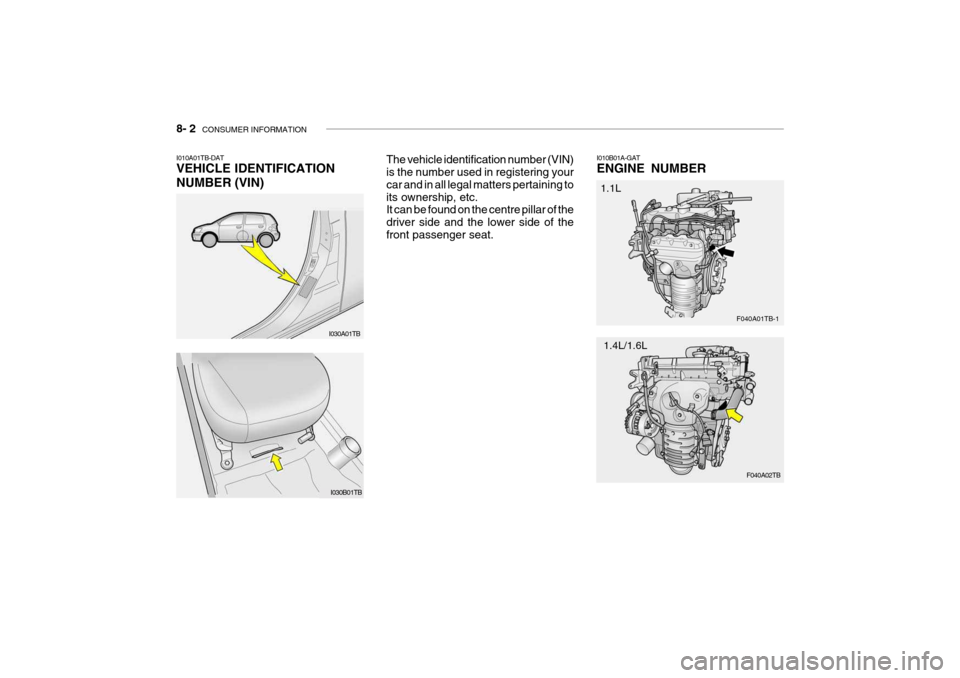
8- 2 CONSUMER INFORMATION
I030A01TB
I010A01TB-DAT VEHICLE IDENTIFICATION NUMBER (VIN)
The vehicle identification number (VIN) is the number used in registering your car and in all legal matters pertaining toits ownership, etc. It can be found on the centre pillar of the driver side and the lower side of thefront passenger seat. I010B01A-GAT ENGINE NUMBER
F040A01TB-1
F040A02TB
1.1L
1.4L/1.6L
I030B01TB
Page 369 of 383
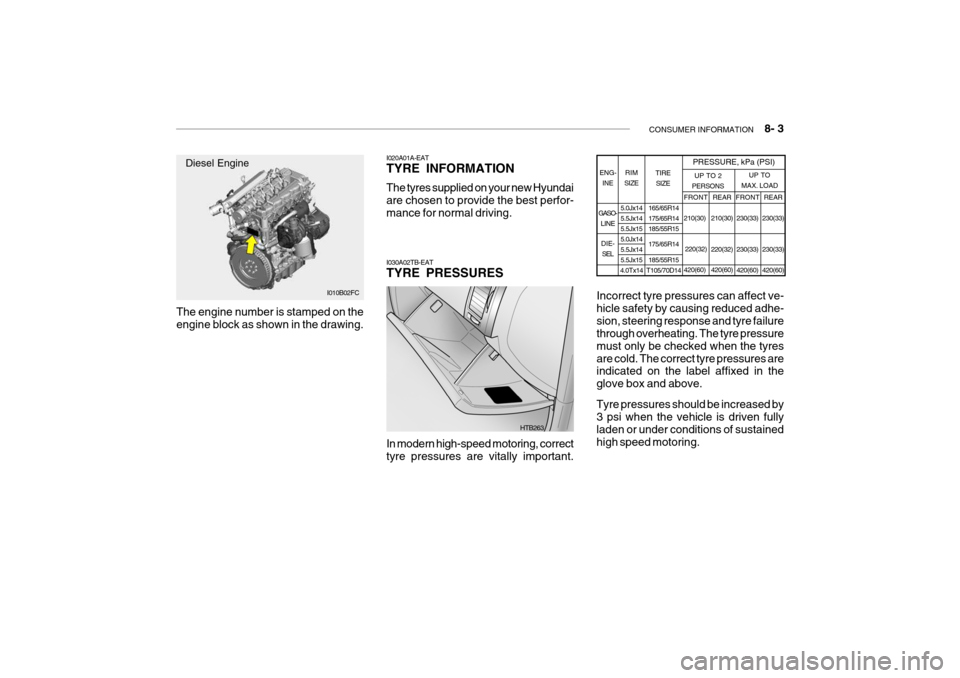
CONSUMER INFORMATION 8- 3
The engine number is stamped on the engine block as shown in the drawing. I030A02TB-EAT TYRE PRESSURES In modern high-speed motoring, correct tyre pressures are vitally important.
I010B02FC
HTB263
Diesel Engine
Incorrect tyre pressures can affect ve-hicle safety by causing reduced adhe-sion, steering response and tyre failure through overheating. The tyre pressure must only be checked when the tyresare cold. The correct tyre pressures are indicated on the label affixed in the glove box and above. Tyre pressures should be increased by 3 psi when the vehicle is driven fully laden or under conditions of sustainedhigh speed motoring.
I020A01A-EAT TYRE INFORMATION The tyres supplied on your new Hyundai are chosen to provide the best perfor-mance for normal driving.
5.0Jx14 5.5Jx14 5.5Jx15 5.0Jx145.5Jx145.5Jx15
4.0Tx14 TIRE
SIZE
RIM
SIZE PRESSURE, kPa (PSI)
165/65R14175/65R14 185/55R15 175/65R14 185/55R15
T105/70D14 REAR
210(30) 220(32) 420(60) FRONT
230(33) 230(33) 420(60)
UP TO 2
PERSONS UP TO
MAX. LOAD
REAR
230(33) 230(33) 420(60)
FRONT210(30)
220(32)
420(60)
ENG- INE
GASO- LINE
DIE- SEL
Page 370 of 383
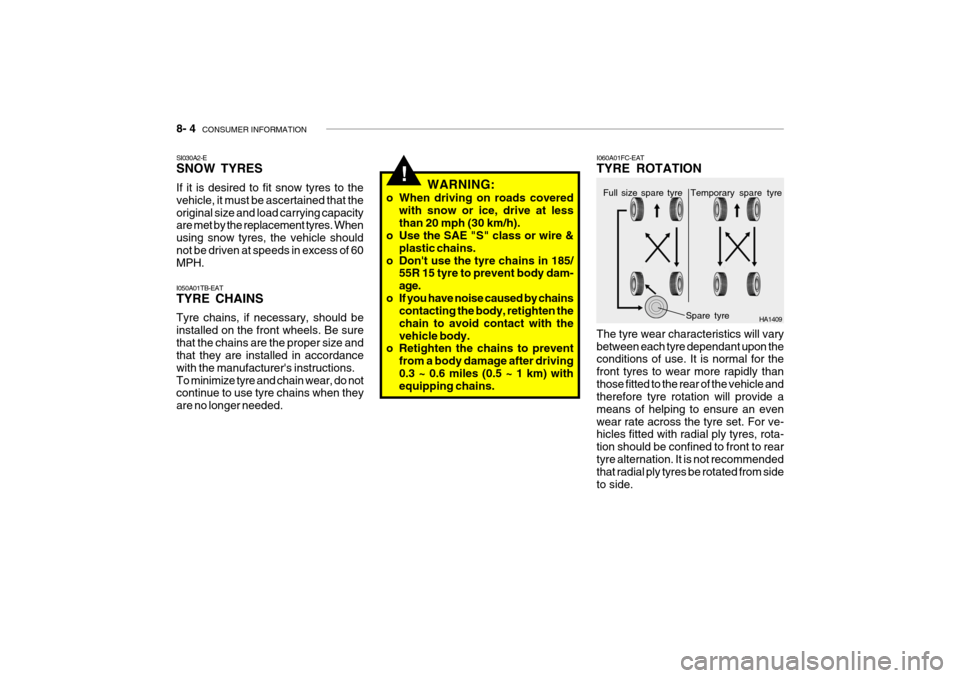
8- 4 CONSUMER INFORMATION
!
I050A01TB-EAT TYRE CHAINS Tyre chains, if necessary, should be installed on the front wheels. Be surethat the chains are the proper size and that they are installed in accordance with the manufacturer's instructions.To minimize tyre and chain wear, do not continue to use tyre chains when they are no longer needed.
SI030A2-E SNOW TYRES If it is desired to fit snow tyres to the vehicle, it must be ascertained that theoriginal size and load carrying capacity are met by the replacement tyres. When using snow tyres, the vehicle shouldnot be driven at speeds in excess of 60 MPH.
I060A01FC-EAT TYRE ROTATION The tyre wear characteristics will vary between each tyre dependant upon the conditions of use. It is normal for the front tyres to wear more rapidly thanthose fitted to the rear of the vehicle and therefore tyre rotation will provide a means of helping to ensure an evenwear rate across the tyre set. For ve- hicles fitted with radial ply tyres, rota- tion should be confined to front to reartyre alternation. It is not recommended that radial ply tyres be rotated from side to side.
WARNING:
o When driving on roads covered with snow or ice, drive at lessthan 20 mph (30 km/h).
o Use the SAE "S" class or wire &
plastic chains.
o Don't use the tyre chains in 185/ 55R 15 tyre to prevent body dam-age.
o If you have noise caused by chains contacting the body, retighten thechain to avoid contact with thevehicle body.
o Retighten the chains to prevent
from a body damage after driving0.3 ~ 0.6 miles (0.5 ~ 1 km) with equipping chains.
HA1409Spare tyre
Full size spare tyre Temporary spare tyre